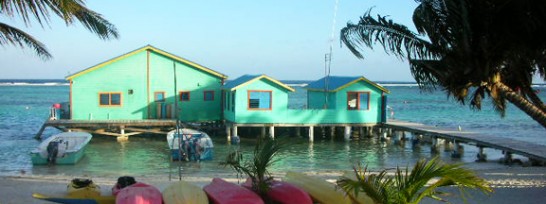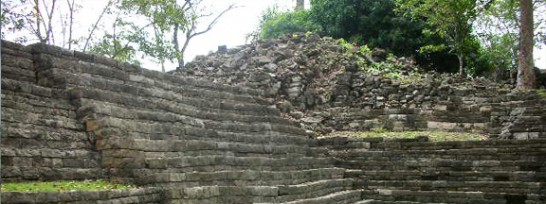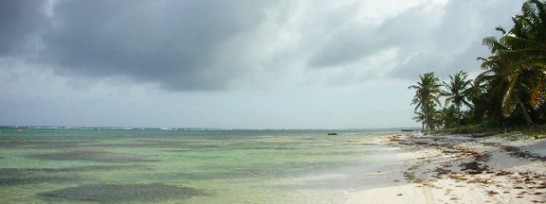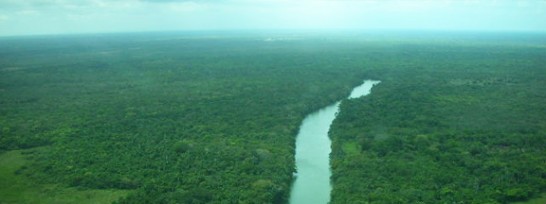
Seventy-five years ago, when Belize was still British Honduras, Aldous Huxley wrote about it. “If the world has any ends, British Honduras would certainly be one of them. It is not on the way from anywhere to anywhere else. It has no strategic value. It is all but uninhabited.”
Some of what Huxley wrote still rings true today. With barely 300,000 residents, Belize is one of the world’s least populated countries. Its most remote district, the Mayan ruin-filled and rainforest-ed Toledo District, has one of the lowest population densities in the world.
And Huxley would still be correct that there’s little to no chance you’ll ever accidentally end up in or pass through Belize. Belize’s national highway – a two-lane road running the length of the country – was only fully paved in early 2009. There are flights into Belize City’s Goldson International Airport from several U.S. gateways, but, once there, your only options are intra-country puddle jumpers never flying higher than 1,200 feet and stopping every five or ten minutes, disgorging and picking up passengers, produce and parcels on dirt runways carved out of the jungle or squeezed between a mangrove forest and a beach. The equivalent of other countries’ bus or train networks, these flights can be as good as the scenic air tours sold in tourist hubs like Ambergris and San Ignacio Cayo (so don’t hesitate to throw an elbow or two to get a window seat).
So what has changed? Although not strategic, there are some recognized valuables in the country nowadays. Belize has some of the most diverse flora and fauna in the world. The second-longest barrier reef in the world is off its coast. There are over 900 Mayan ruins in the country. Visitors also value its sense of remoteness (although with both Miami and Houston little more than a two-hour flight away, it’s hard to make the argument that Belize is truly remote).
Whether because of Belize’s natural beauty, archeology sites or cultural heritage, the country now gets almost as many visitors a year as it has residents. While half of the visitors to the country never make it off the beach, we recommend a vacation that includes both reef and rainforest.

First Stop: Reef
The flight from Belize City to Ambergris Caye, the largest of the 200+ cayes – pronounced “keys” off the coast of Belize, is 20 minutes. Because Belize’s 185-mile long barrier reef is a short boat-ride off shore and dozens of lodging options, art galleries, and souvenir shops have popped up in the last decade – not to mention a lively nightlife — San Pedro has become Belize’s most popular tourist destination. (The fact that the Madonna song La Isla Bonita is about San Pedro helps the town’s popularity as well. When she visited and wrote the song, San Pedro was still a sleepy fishing village however. Several years ago, the first season of the Fox reality show Temptation Island was filmed here). So, if you’re looking for a social scene and nightlife with your beach, snorkeling, diving, and fishing, San Pedro Town is your place. You can spend all day on the beach or in (or under) the water and all night singing karaoke, eating sushi (or Italian, or Thai…) and dancing.

A little about the water and barrier reef: Just south and just offshore of San Pedro is the Hol Chan Marine Reserve. (Hol Chan is Mayan for “little channel.”) Established in 1987, Hol Chan covers about three square miles and has enough dive/snorkeling sites to keep you busy for several days. The reserve focuses on a 90-foot wide cut, or channel (hence the name), through the reef, the longest in the Western Hemisphere; in the world, only Australia’s Great Barrier Reef is longer. The bottom of the channel is about 30 feet down, making it a perfect destination for a groups that include both divers and snorkelers. Expect to see a wide variety of coral, even if their colors aren’t as vibrant as they once were (much of the reef has experienced some bleaching).
Shark-Ray Alley, a few minutes’ boat ride from Hol Chan, is worth a dive/snorkel too. This sandy swath is short of coral, but you’re pretty much guaranteed to spot at least one nurse or reef shark there. If you’re lucky? Up to a dozen, along with a manta ray or two. Visibility at these shallow sites can be up to 150 feet. The only number potentially more impressive is that of the water temperature. Even during the coldest month of the year – February – the water only dips down to 79 degrees. (In the warmest months – August – October – the temperatures get up to 84.) All dive shops in San Pedro offer trips to Hol Chan, Shark-Ray Alley and maze-like deeper sites (70 to 80 feet deep).
While San Pedro is the only real town on Ambergris, there are self-contained resorts further north. At the far – far – north of the caye, Tranquility Bay Resort lives up to its name. It’s only a 45-minute boat ride from San Pedro, but feels like another planet. Gone are all the golf carts and bikes – the main methods of transportation in San Pedro. Gone are the t-shirt shops. Same for the street vendors. And crowds of tourists. Hammocks strung between palm trees are plentiful. So are kayaks. Dolphins swim just off shore in the evenings. From your beachfront cabana, you can walk to the point the barrier reef meets the shore. You can’t walk to any restaurants besides the Tackle Box, which is part of Tranquility Bay. You can sometimes get a wireless Internet signal. You can always arrange for a diving or fishing guide. The reef is a half-mile off shore here, if even that.
Next Stop: Rainforest

Sixty percent of Belize’s 8,866 square miles (making the country only slightly larger than Massachusetts) is forested. Within these forests, scientists have counted over 4,000 species of flowering plants and 700 species of trees. In contrast, the U.S. and Canada together support about 730 species. This mean that, on average, Belize has 1,000 times the plant diversity per square mile than the U.S. and Canada. Over 500 species of birds either winter or live year-round in Belize. On the ground, there are tapirs (think of crossing a hippo with an anteater), jaguars, crocodiles and howler monkeys.
Get the most out of a visit to the rainforest by heading for the remotest, least populated district of the country, Toledo, in the far south. Punta Gorda, or “PG,” is Toledo’s main town. Twenty minutes from the PG airport, which is a 40-minute flight from Belize City, Machaca Hill Rainforest Canopy Lodge is the perfect base. Surrounded by a 12,000-acre private preserve, Machaca’s rooms are individual cabanas tucked into the forest canopy. A veranda wraps around the main lodge; sit in a chaise here and use a spotting scope to find toucans and black howler monkeys. (The latter make it very easy for you; their screeching gives them the dubious distinction of being one of the ten loudest animals in the world.) Machaca’s staff includes native Belizean guides, many of whom are former employees of the Belize chapter of the Nature Conservancy. Guides are around the property to answer questions. Even better is to grab a guide and one of Machaca’s open-topped Land Cruisers and head off-property to millennium-old Mayan ruins like Nim La Punit or to the modern Mayan village of Blue Creek. The best culture class? Get a hands-on lesson in Mayan farming with a visit to a cacao farm. Help transform a cacao pod into chocolate (!) and then take your hard work back to Machaca for Chef Ken Gundu to turn into dessert.
{niftybox width=600}
Practical Information
Belize requires visitors present a passport to enter and exit, but nationals of the U.S., Australia, Canada, Hong Kong, Mexico, New Zealand, Norway, Venezuela, CARICOM member states and European Union member countries do not require visas. English is the official language and the Belizean dollar is fixed to the U.S. dollar at $2 BZD = $1U.S. Most places accept US dollars, so it isn’t necessary to exchange currency.
Where to Sleep:
Cayo Espanto On its own private island a short boat ride from San Pedro, Cayo is the ultimate in luxury and seclusion. Not the place to be if you want to party … or even play chatty with fellow guests. It is the perfect place for feeling like you’ve fallen off the face of the Earth. 888-666-4282. www.aprivateisland.com
Tranquility Bay Resort A laid-back resort for serious divers and fishermen. At the far-northern end of Ambergris, it’s got the shortest commute to the barrier reef of any resort on the caye. 888-843-2293 or 011-501-220-5880. www.tranquilitybayresort.com
Machaca Hill Rainforest Canopy Lodge A luxury, eco-conscious property that’s a good value. Make sure to enjoy afternoon tea on the veranda overlooking the rainforest and borrow a kayak to paddle on the nearby Rio Grande. Punta Gorda. 011 501 722 0050. www.machacahill.com
Where to Eat and Drink:
Celi’s Deli: Located next to the San Pedro Holiday Hotel. The empanadas, tamales and pork tacos here are fine, but go straight for Celi’s Caye Lime Pie. And don’t plan on sharing a slice with a friend or partner. One bite and you’ll each want your own.
Fido’s Restaurant and Bar: Come here first for a lunch under a palapa on the beach. Return after 9 p.m. for live music. San Pedro Town. www.fidosbelize.com
Cool Spot: Being Belize’s most remote and least populated district and all, Toledo doesn’t have fancy restaurants. It does however, have “cool spots” dotting most every road. What’s a cool spot? What Belizeans call their outdoor bars and restaurants. Most have dirt or concrete floors, serve up Guinness and Belikin beer and have a simple menu with beans and rice and stewed chicken. And perhaps gibnut, which you should steer clear of unless you’re prepared to chow down on the rodent known elsewhere as a paca.
Coleman’s Café: Outside Punta Gorda, just off the Southern Highway on the entrance road to Rice Mill, Coleman’s serves authentic home-cooked meals — Creole dishes, cohune cabbage and East Indian curries. Slightly – only slightly – more formal than a cool spot. (501)720-2017. (They don’t have a website or real address.)
What to See and Do:
Barrier Reef: The ultimate for fish watching and catching. The further north you are in the country, the shorter the boat ride out to the reef. But the further south you are, the fewer people; however it’s perfectly fine to check out both ends.
Mayan Ruins: Lubaantun and Nim Li Punit are two of the Toledo District’s bigger Mayan sites. Neither has crowds though. Both date from the Maya Classic Period, were inhabited in the 700s and, like many Mayan sites in the country, seem to have been suddenly abandoned in the 9th century. At Nim Li Punit, don’t miss the stelae carved with illustrations of the city’s rulers.

